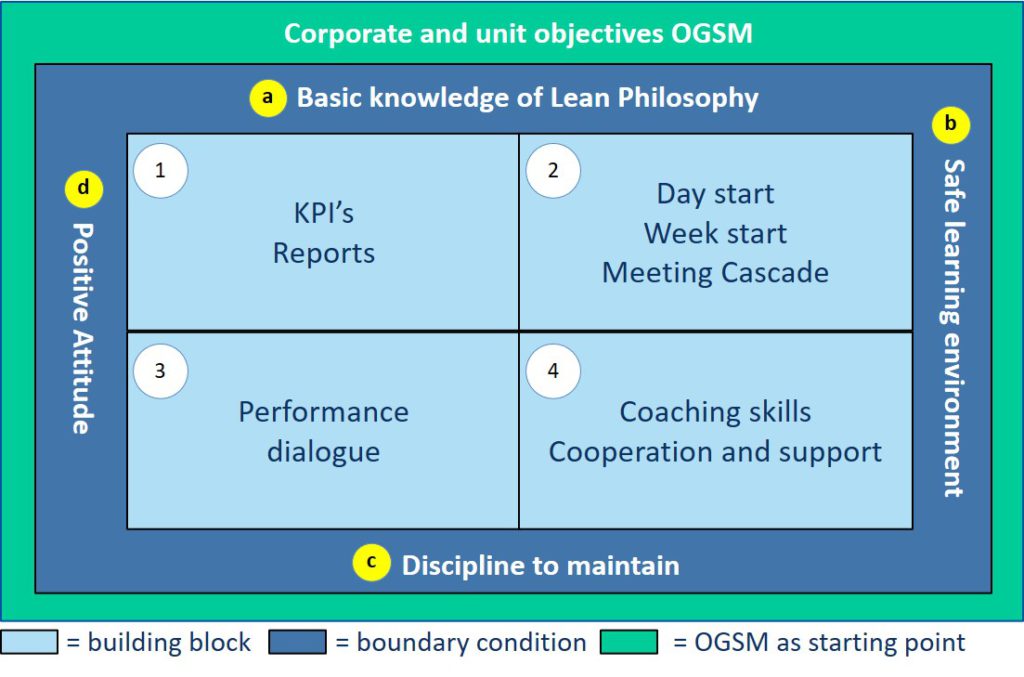In our last blog, you read about the principles that underlie our performance management approach. We explained that you need to look at performance with a holistic approach, focus on impact instead of tools and build capabilities in your team. In this blog, we will explain the four building blocks that make up our approach.
Performance management based on Objectives, Goals, Strategies and Measures (OGSM)
As explained in the last blog, we start with defining goals, using the OGSM approach. Once the overall objectives, goals, strategies and measures of your organisation have been set, the next step can be taken: implementation of a performance management framework. To do this in a structured way, we have defined a four-step approach: KPI’s and reports, a well structured meeting cascade with day and week starts, performance dialogues and coaching, cooperation and support.
Figure 1: Key elements of performance management
Four building blocks
- Define the business KPI’s and reports
Based on the OGSM framework that has been set up the right KPI’s have to defined to enable effective steering. Setting up KPI’s is a delicate task. The main pitfalls are:
A. to define far too many KPI’s. A set of six to eight KPI’s is about the maximum for anyone person to manage. This restriction is quite hard, it may require a lot of thinking before you come to the essence of what you need to measure to steer effectively
B. to define the wrong KPI’s: a set of KPI’s need to be MECE: mutually exclusive and collectively exhaustive. The set of KPI’s you define need to cover the entire set of activities, but the must not overlap.
C. to define only lagging KPI’s: to be able to steer effectively leading KPI’s are required. Let’s say you want to lose weight. It does not make sense to only take body weight as a KPI’s because you cannot influence it directly. It is a consequence of calories intake and physical exercise, in this case the leading KPI’s
Once the KPI’s have been defined the reports have to be built so the KPI’s can be discussed in the appropriate setting.
- Day starts, week starts and meeting cascade
To enable effective steering a well-structured meeting cascade is required. It provides alignment and cadence in the information flow throughout the organisation via the key business steering meetings, like management team meeting, weekly performance review and day start. The meeting structure is cascaded and KPI’s are connected from senior management to the shopfloor. We have seen many examples in our practice where implementation of a coherent meeting cascade increases productivity by up to 15%, reduces time spent in meetings by 30% and increases employee satisfaction as a consequence. Just think of how much happier you would be without some of those unnecessary, often boring meetings.
- Performance Dialogues
Once the KPI’s and the meetings have been defined, the performance dialogue can take place. A performance dialogue is a conversation between a team member and the manager about the performance of the person. This is not about critique or personal feedback, but about simple results and actions. In the execution of the performance dialogue there are two main points of attention:
A. Do it in a structured way, so people can prepare properly. It does not make sense to ask questions in a performance dialogue that people can not anticipate. It is highly likely that this will cause frustration and rejection of the whole concept of doing a Performance Dialogue. We have found in our practice the use of the STARPADS concept quite powerful. See figure 3 for a brief explanation of the concept.
B. Keep it positive. Remember that the concept of performance management is aimed at increasing performance, not bashing people for a red or orange KPI. The Performance Dialogue is a dialogue, not an interrogation. It should enable your team members to learn how to find root causes for their problems and be truly open on where they are successful and where improvements can be made. The team is engaged and supports each other in an active manner.
Figure 2: STARPADS framework for effective performance dialogues
- Coaching skills, cooperation and support
To be able to run a day-start, week-start or a performance dialogue, people need to learn how to ask open ended questions and give constructive feedback. This requires training, coaching and on-the-job mentoring for the people doing the performance dialogue. Items that we see in our practice that take effort to overcome are to get people to:
A. Do the homework: the idea is that the STARPADS method provides a framework that enables people to come to the meeting with answers. This means they have to do the analyses upfront, not in the meeting!
B. Take ownership: steer away from the ‘yes but,…’ answers.
We take the development of the skills and competencies in your organisation very seriously. To drive this topic we use the ‘train the trainer’ concept and take an approach that creates sustainability.
Figure 4: HillFive approach for capability building
As most of the tools we use are Lean and Agile based we use Digital Learning to help team members to receive basic knowledge before they participate in the project. Time is well spent when employees already have learnt the basics before the project starts.
Sustainability is created by truly connecting the hierarchical levels in an open and transparent way. We provide guidance and support for people to discuss performance in an open way. Results are delivered which provides the energy for sustaining the performance management culture.
We wish you all the best in continuously improving performance across all four dimensions.




